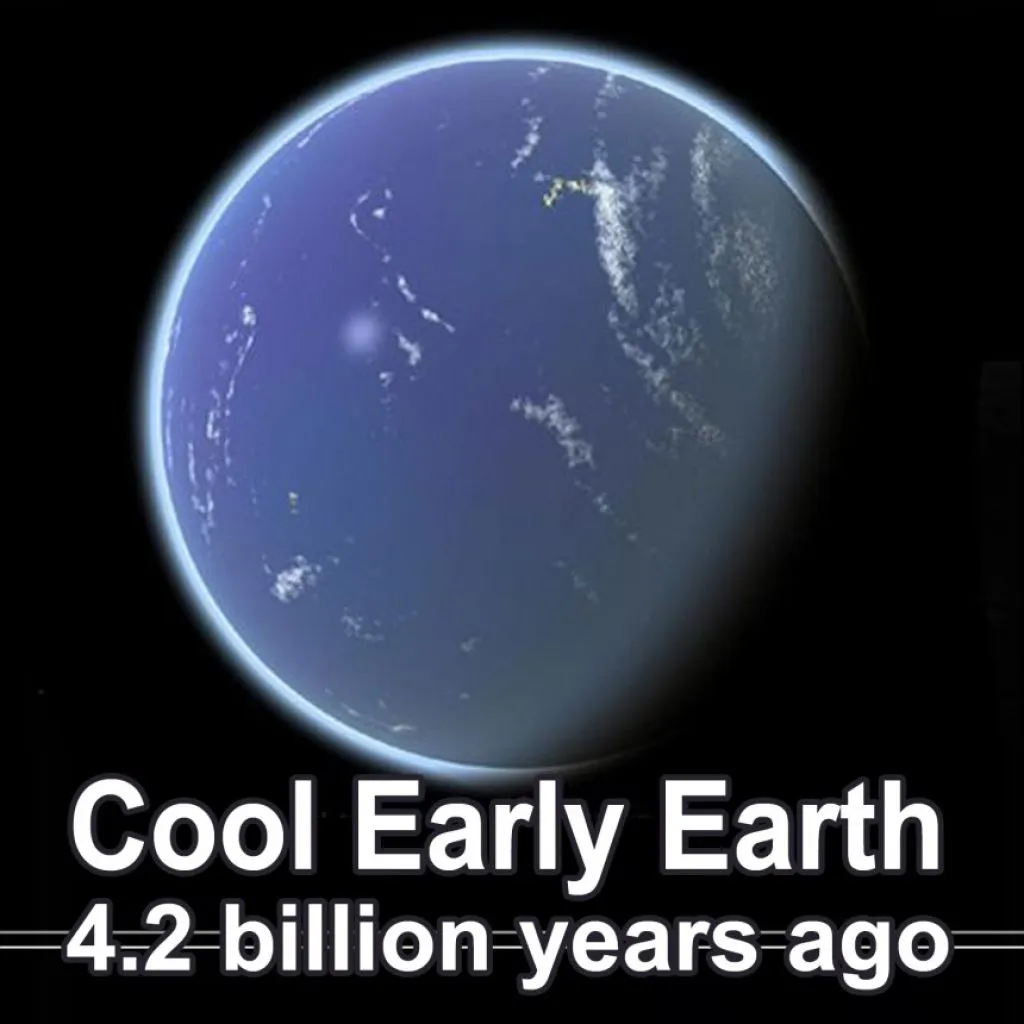
Cool Early Earth
The cool early Earth (CEE) theory posits that for part of the Hadean geological eon, at the beginning of the Earth's history, it had a modest influx of bolides and a cool climate, allowing the presence of liquid water.
This would have been after the extreme conditions of earth's earliest history between 4.6 and 4.4 billion years ago, but before the Late Heavy Bombardment of 4.1 to 3.8 billion years ago.
In 2002 John Valley and others argued that detrital zircons found in Western Australia, dating to 4.0-4.4 billion years ago, were formed at relatively low temperatures, that meteorite impacts may have been less frequent than previously thought, and that the earth may have gone through long periods when liquid oceans and life were possible.
In 2016 Gavin Kenny and others replied to suggestions that zircons were formed by melting during tectonic subduction at plate boundaries, and argued that at least some of them were formed by meteorite impacts.
FAINT YOUNG SUN PARADOX
The faint young Sun paradox describes the apparent contradiction between observations of liquid water early in Earth's history and the astrophysical expectation that the Sun's output would be only 70 percent as intense during that epoch as it is during the modern epoch.
The issue was raised by astronomers Carl Sagan and George Mullen in 1972. Explanations of this paradox have taken into account greenhouse effects, astrophysical influences, or a combination of the two.
The unresolved question is how a climate suitable for life was maintained on Earth over the long timescale despite the variable solar output and wide range of terrestrial conditions.
EARLY SOLAR OUTPUT
Early in Earth's history, the Sun's output would have been only 70 percent as intense as it is during the modern epoch.
In the environmental conditions existing at that time, this solar output would have been insufficient to maintain a liquid ocean. Astronomers Carl Sagan and George Mullen pointed out in 1972 that this is contrary to the geological and paleontological evidence.
According to the Standard Solar Model, stars similar to the Sun should gradually brighten over their main sequence lifetime due to contraction of the stellar core caused by fusion.
However, with the predicted solar luminosity 4 billion (4 × 109) years ago and with greenhouse gas concentrations the same as are current for the modern Earth, any liquid water exposed to the surface would freeze.
However, the geological record shows a continually relatively warm surface in the full early temperature record of Earth, with the exception of a cold phase, the Huronian glaciation, about 2.4 to 2.1 billion years ago.
Water-related sediments have been found dating to as early as 3.8 billion years ago. Hints of early life forms have been dated from as early as 3.5 billion years, and the basic carbon isotopy is very much in line with what is found today.
GREENHOUSE HYPOTHES
When it first formed, Earth's atmosphere may have contained more greenhouse gases.
Carbon dioxide concentrations may have been higher, with estimated partial pressure as large as 1,000 kPa (10 bar), because there was no bacterial photosynthesis to convert the CO2 gas to organic carbon and gaseous oxygen.
Methane, a very active greenhouse gas that reacts with oxygen to produce carbon dioxide and water vapor, may have been more prevalent as well, with a mixing ratio of 10−4 (100 parts per million by volume).
Based on a study of geological sulfur isotopes, in 2009 a group of scientists including Yuichiro Ueno from the Tokyo Institute of Technology proposed that carbonyl sulfide (OCS) was present in the Archean atmosphere.
Carbonyl sulfide is an efficient greenhouse gas and the scientists estimate that the additional greenhouse effect would have been sufficient to prevent Earth from freezing over.
Based on an "analysis of nitrogen and argon isotopes in fluid inclusions trapped in 3.0 to 3.5 billion-year-old hydrothermal quartz" a 2013 paper concludes that "dinitrogen did not play a significant role in the thermal budget of the ancient Earth and that the Archean partial pressure of CO2 was probably lower than 0.7 bar".
Burgess, one of the authors states
The amount of nitrogen in the atmosphere was too low to enhance the greenhouse effect of carbon dioxide sufficiently to warm the planet. However, our results did give a higher than expected pressure reading for carbon dioxide – at odds with the estimates based on fossil soils – which could be high enough to counteract the effects of the faint young Sun and will require further investigation.
Also, in 2012-2016 the research by S.M. Som, based on the analysis of raindrop impressions and air bubbles trapped in ancient lavas, have further indicated a low atmospheric pressure below 1.1 bar and probably as low as 0.23 bar during an epoch 2.7 bn years from present.
Following the initial accretion of the continents after about 1 billion years, geo-botanist Heinrich Walter and others contend that a non-biological version of the carbon cycle provided a negative temperature feedback.
The carbon dioxide in the atmosphere dissolved in liquid water and combined with metal ions derived from silicate weathering to produce carbonates. During ice age periods, this part of the cycle would shut down. Volcanic carbon emissions would then restart a warming cycle due to the greenhouse effect.
According to the Snowball Earth hypothesis, there may have been a number of periods when Earth's oceans froze over completely. The most recent such period may have been about 630 million years ago. Afterwards, the Cambrian explosion of new multicellular life forms started.

















































